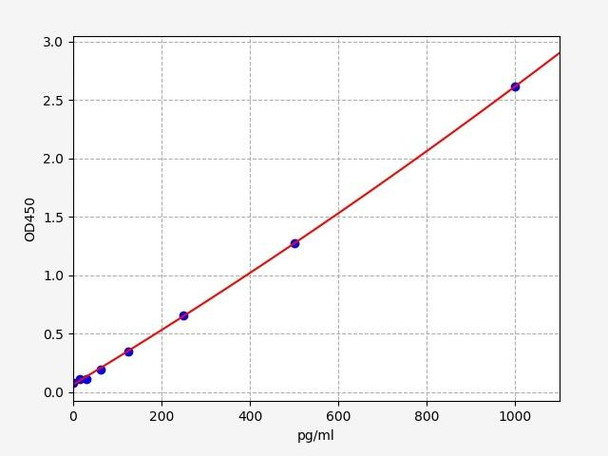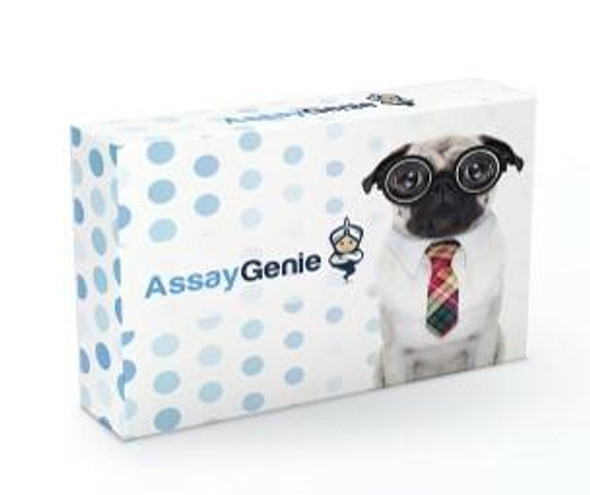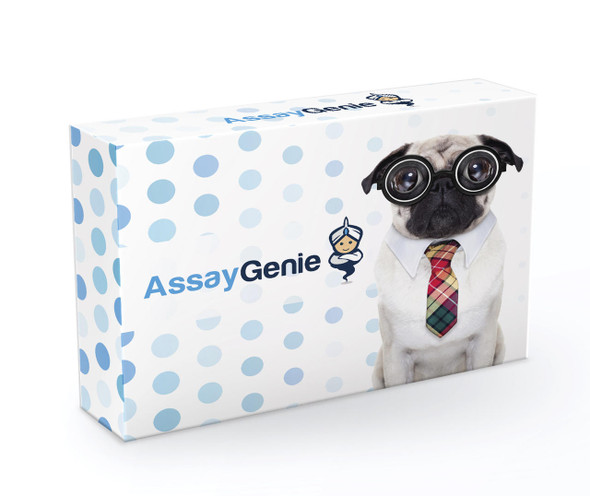Rat SCF ELISA Kit (RTFI01114)
- SKU:
- RTFI01114
- Product Type:
- ELISA Kit
- Size:
- 96 Assays
- Uniprot:
- P21581
- Sensitivity:
- 9.375pg/ml
- Range:
- 15.625-1000pg/ml
- ELISA Type:
- Sandwich
- Synonyms:
- SCF, c-kit Ligand, KITLG, MGF, SLF, c-kit Ligand, DKFZp686F2250, familial progressive hyperpigmentation 2, FPH2, KIT ligand, Kitl, KITLG, KL-1, Mast cell growth factor, MGF, MGFSHEP7, SCFStem cell factor, SFc-Kit ligand, SLF, steel factor
- Reactivity:
- Rat
- Research Area:
- Cell Biology
Description
Rat SCF ELISA Kit
The Rat SCF (Stem Cell Factor) ELISA Kit is a valuable tool for precise quantification of SCF levels in rat serum, plasma, and tissue homogenates. With its exceptional sensitivity and specificity, this kit guarantees accurate and consistent results, making it suitable for a variety of research purposes.Stem Cell Factor, also known as c-kit ligand, is a vital cytokine that regulates the growth, differentiation, and survival of stem cells and progenitor cells.
Its role in hematopoiesis, tissue regeneration, and immune response makes it a key target in studies related to regenerative medicine, cancer, and immunology. The Rat SCF ELISA Kit provides researchers with a reliable method to explore the functions and potential therapeutic applications of SCF in various biological processes.
| Product Name: | Rat SCF (Stem Cell Factor) ELISA Kit |
| Product Code: | RTFI01114 |
| Size: | 96 Assays |
| Target: | Rat SCF |
| Alias: | SCF, c-kit Ligand, KITLG, MGF, SLF, c-kit Ligand, DKFZp686F2250, familial progressive hyperpigmentation 2, FPH2, KIT ligand, Kitl, KITLG, KL-1, Mast cell growth factor, MGF, MGFSHEP7, SCFStem cell factor, SFc-Kit ligand, SLF, steel factor |
| Reactivity: | Rat |
| Detection Method: | Sandwich ELISA, Double Antibody |
| Sensitivity: | 9.375pg/ml |
| Range: | 15.625-1000pg/ml |
| Storage: | 4°C for 6 months |
| Note: | For Research Use Only |
| Recovery: | Matrices listed below were spiked with certain level of Rat SCF and the recovery rates were calculated by comparing the measured value to the expected amount of Rat SCF in samples. | ||||||||||||||||
| |||||||||||||||||
| Linearity: | The linearity of the kit was assayed by testing samples spiked with appropriate concentration of Rat SCF and their serial dilutions. The results were demonstrated by the percentage of calculated concentration to the expected. | ||||||||||||||||
| |||||||||||||||||
| Intra-Assay: | CV <8% | ||||||||||||||||
| Inter-Assay: | CV <10% |
| Uniprot: | P21581 |
| UniProt Protein Function: | SCF: Ligand for the receptor-type protein-tyrosine kinase KIT. Plays an essential role in the regulation of cell survival and proliferation, hematopoiesis, stem cell maintenance, gametogenesis, mast cell development, migration and function, and in melanogenesis. KITLG/SCF binding can activate several signaling pathways. Promotes phosphorylation of PIK3R1, the regulatory subunit of phosphatidylinositol 3-kinase, and subsequent activation of the kinase AKT1. KITLG/SCF and KIT also transmit signals via GRB2 and activation of RAS, RAF1 and the MAP kinases MAPK1/ERK2 and/or MAPK3/ERK1. KITLG/SCF and KIT promote activation of STAT family members STAT1, STAT3 and STAT5. KITLG/SCF and KIT promote activation of PLCG1, leading to the production of the cellular signaling molecules diacylglycerol and inositol 1,4,5- trisphosphate. KITLG/SCF acts synergistically with other cytokines, probably interleukins. Homodimer, non-covalently linked (Probable). Heterotetramer with KIT, binding two KIT molecules; thereby mediates KIT dimerization and subsequent activation by autophosphorylation. Belongs to the SCF family. 3 isoforms of the human protein are produced by alternative splicing. |
| UniProt Protein Details: | Protein type:Membrane protein, integral Cellular Component: extracellular space; cytoskeleton; membrane; cytoplasm; extracellular region; integral to membrane; plasma membrane Molecular Function:growth factor activity; cytokine activity; stem cell factor receptor binding Biological Process: positive regulation of MAP kinase activity; positive regulation of peptidyl-tyrosine phosphorylation; ovarian follicle development; positive regulation of melanocyte differentiation; negative regulation of mast cell apoptosis; embryonic hemopoiesis; positive regulation of cell proliferation; germ cell programmed cell death; male gonad development; positive regulation of Ras protein signal transduction; positive regulation of myeloid leukocyte differentiation; cell adhesion; neural crest cell migration; positive regulation of DNA replication; negative regulation of apoptosis |
| NCBI Summary: | soluble growth factor that activates c-kit tyrosine kinase receptor; important for signaling in spermatogenesis; putative regulator of Leydig cell development [RGD, Feb 2006] |
| UniProt Code: | P21581 |
| NCBI GenInfo Identifier: | 22654283 |
| NCBI Gene ID: | 60427 |
| NCBI Accession: | P21581.2 |
| UniProt Secondary Accession: | P21581,Q9QWZ4, Q9Z2E7, |
| UniProt Related Accession: | P21581 |
| Molecular Weight: | 27,681 Da |
| NCBI Full Name: | Kit ligand |
| NCBI Synonym Full Names: | KIT ligand |
| NCBI Official Symbol: | Kitlg |
| NCBI Official Synonym Symbols: | Mgf; SCF; Kitl |
| NCBI Protein Information: | kit ligand; C-kit ligand; stem cell factor KL-1; mast cell growth factor; steel factor/kit ligand; hematopoietic growth factor KL |
| UniProt Protein Name: | Kit ligand |
| UniProt Synonym Protein Names: | Hematopoietic growth factor KL; Mast cell growth factor; MGF; Stem cell factor; SCF; c-Kit ligandCleaved into the following chain:Soluble KIT ligand; sKITLG |
| Protein Family: | SCF-associated factor |
| UniProt Gene Name: | Kitlg |
| UniProt Entry Name: | SCF_RAT |
| Step | Procedure |
| 1. | Set standard, test sample and control (zero) wells on the pre-coated plate respectively, and then, record their positions. It is recommended to measure each standard and sample in duplicate. Wash plate 2 times before adding standard, sample and control (zero) wells! |
| 2. | Aliquot 0.1ml standard solutions into the standard wells. |
| 3. | Add 0.1 ml of Sample / Standard dilution buffer into the control (zero) well. |
| 4. | Add 0.1 ml of properly diluted sample ( Human serum, plasma, tissue homogenates and other biological fluids.) into test sample wells. |
| 5. | Seal the plate with a cover and incubate at 37°C for 90 min. |
| 6. | Remove the cover and discard the plate content, clap the plate on the absorbent filter papers or other absorbent material. Do NOT let the wells completely dry at any time. Wash plate X2. |
| 7. | Add 0.1 ml of Biotin- detection antibody working solution into the above wells (standard, test sample & zero wells). Add the solution at the bottom of each well without touching the side wall. |
| 8. | Seal the plate with a cover and incubate at 37°C for 60 min. |
| 9. | Remove the cover, and wash plate 3 times with Wash buffer. Let wash buffer rest in wells for 1 min between each wash. |
| 10. | Add 0.1 ml of SABC working solution into each well, cover the plate and incubate at 37°C for 30 min. |
| 11. | Remove the cover and wash plate 5 times with Wash buffer, and each time let the wash buffer stay in the wells for 1-2 min. |
| 12. | Add 90 µL of TMB substrate into each well, cover the plate and incubate at 37°C in dark within 10-20 min. (Note: This incubation time is for reference use only, the optimal time should be determined by end user.) And the shades of blue can be seen in the first 3-4 wells (with most concentrated standard solutions), the other wells show no obvious color. |
| 13. | Add 50 µL of Stop solution into each well and mix thoroughly. The color changes into yellow immediately. |
| 14. | Read the O.D. absorbance at 450 nm in a microplate reader immediately after adding the stop solution. |
When carrying out an ELISA assay it is important to prepare your samples in order to achieve the best possible results. Below we have a list of procedures for the preparation of samples for different sample types.
| Sample Type | Protocol |
| Serum: | If using serum separator tubes, allow samples to clot for 30 minutes at room temperature. Centrifuge for 10 minutes at 1,000x g. Collect the serum fraction and assay promptly or aliquot and store the samples at -80°C. Avoid multiple freeze-thaw cycles. If serum separator tubes are not being used, allow samples to clotovernight at 2-8°C. Centrifuge for 10 minutes at 1,000x g. Removeserum and assay promptly or aliquot and store the samples at-80°C. Avoid multiple freeze-thaw cycles. |
| Plasma: | Collect plasma using EDTA or heparin as an anti-coagulant. Centrifuge samples at 4°C for 15 mins at 1000 × g within 30 mins of collection. Collect the plasma fraction and assay promptly or aliquot and store the samples at -80°C. Avoid multiple freeze-thaw cycles.Note: Over haemolysed samples are not suitable for use with this kit. |
| Urine & Cerebrospinal Fluid: | Collect the urine (mid-stream) in a sterile container, centrifuge for 20 mins at 2000-3000 rpm. Remove supernatant and assay immediately. If any precipitation is detected, repeat the centrifugation step. A similar protocol can be used for cerebrospinal fluid. |
| Cell Culture Supernatant: | Collect the cell culture media by pipette, followed by centrifugation at 4°C for 20 mins at 1500 rpm. Collect the clear supernatant and assay immediately. |
| Cell Lysates: | Solubilize cells in lysis buffer and allow to sit on ice for 30 minutes. Centrifuge tubes at 14,000 x g for 5 minutes to remove insoluble material. Aliquot the supernatant into a new tube and discard the remaining whole cell extract. Quantify total protein concentration using a total protein assay. Assay immediately or aliquot and store at ≤ -20°C. |
| Tissue Homogenates: | The preparation of tissue homogenates will vary depending upon tissue type. Rinse tissue with 1X PBS to remove excess blood & homogenizein 20ml of 1X PBS (including protease inhibitors) and store overnight at ≤ -20°C. Two freeze-thaw cycles are required to break the cell membranes. To further disrupt the cell membranes you can sonicate the samples. Centrifuge homogenates for 5 mins at 5000xg. Remove the supernatant and assay immediately or aliquot and store at -20°C or-80°C. |
| Tissue Lysates: | Rinse tissue with PBS, cut into 1-2 mm pieces, and homogenize with a tissue homogenizer in PBS. Add an equal volume of RIPA buffer containing protease inhibitors and lyse tissues at room temperature for 30 minutes with gentle agitation. Centrifuge to remove debris. Quantify total protein concentration using a total protein assay. Assay immediately or aliquot and store at ≤ -20 °C. |
| Breast Milk: | Collect milk samples and centrifuge at 10,000 x g for 60 min at 4°C. Aliquot the supernatant and assay. For long term use, store samples at -80°C. Minimize freeze/thaw cycles. |






